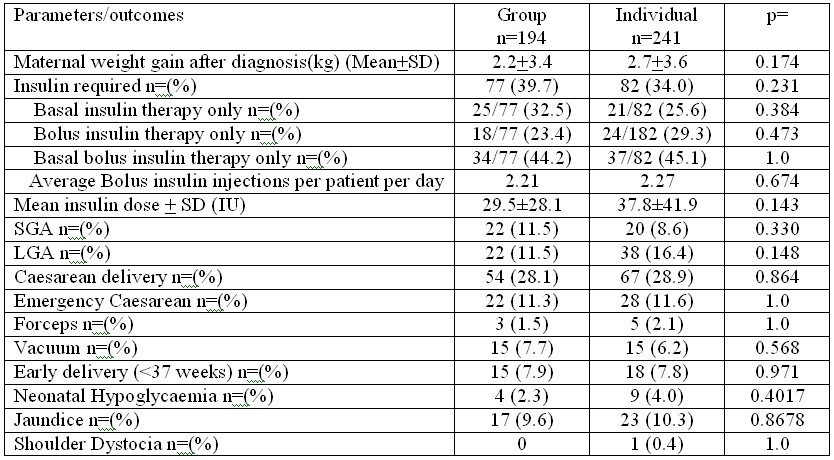COMPARISON OF GROUP VERSUS INDIVIDUAL DIETARY EDUCATION FOR WOMEN WITH GESTATIONAL DIABETES (#40)
Background: For almost 20 years, women referred for Gestational Diabetes Mellitus (GDM) management received one-to-one dietary education from a dietitian. As incidence rates have rapidly increased in recent years, we now provide education in a group setting. There is limited evidence on the effectiveness and outcomes of group versus one-to-one dietary education for women with GDM.
Aim: To compare group versus individual dietary education in terms of insulin therapy requirements and pregnancy outcomes in women with GDM.
Methods: All English speaking women who received one initial individual appointment with a dietitian (1-2-2011 to 31-1-2012) (Individual) were compared to women who received initial education in a group setting (1-2-2012 to 31-12013) (Group), all followed by at least one individual dietitian appointment usually within two weeks. The same dietary information was provided in both settings. Data collected were: attendance rates, insulin requirement, maternal weight gain, rates of SGA, LGA, mode of delivery, and rates of delivery complications. Data were compared by t-test or Chi-squared test. Fisher-Freeman-Halton exact test was used to detect differences in ethnicity. Statistical significance was p<0.05.
Results: There were 194 women (Group) and 241 (Individual). Group women were slightly older (32.3 ± 4.9 versus 31.1±5.1 p=0.016). There was no difference in ethnicity or other baseline characteristics. Attendance at the first appointment was 80.8% (Group) and 89.9% (Individual)(p=0.006). Attendance rates at GDM multidisciplinary clinic one week later were 79.4% (Group) and 81.7% (Individual) (p=0.5437), average days between initial and first follow-up dietary advice visit being 8.5 days (Group) and 9 days (Individual). Women requiring bolus insulin to control post-prandial glucose was similar: 26.8% (Group) and 25.3% (Individual) (p=0.7424). The Table shows other parameters, none of which were statistically different.

Conclusion: Apart from lower initial attendance which is of concern, group education was not inferior to individual education when followed by an individual appointment, and is therefore a useful alternative where dietetic services are limited.
